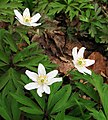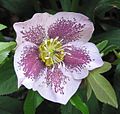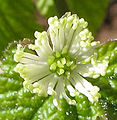Ranunculaceae
| Ranunculaceae | |
|---|---|

| |
| Ranunculus auricomus (type species) | |
| Scientific classification | |
| Kinrick: | Plantae |
| (unranked): | Angiosperms |
| (unranked): | Eudicots |
| Order: | Ranunculales |
| Faimily: | Ranunculaceae Juss. |
| Subfaimilies | |
Ranunculaceae (buttercup or crowfoot faimily; Latin rānunculus "little frog", frae rāna "frog") is a faimily o aboot 1700 species o flouerin plants in aboot 60 genera, distributit warldwide.
The lairgest genera are Ranunculus (600 speshies), Delphinium (365), Thalictrum (330), Clematis (325), an Aconitum (300).
Description[eedit | eedit soorce]

Ranunculaceae are maistly yerbaceous plants, but wi some widy climbers (sic as Clematis) an subshrubs (e.g. Xanthorhiza).

Memmers o the Ranunculaceae uisually hae five coloured sepals insteid o petals (except buttercups), an dividit leaves an nonwidy tissue (except clematis). [1] Leaves are uisually dividit or lobed, but are hert-shaped or nairae an undividit in some speshies o Ranunculus, an uisually arise frae the base o the plant, or alternately up the stem, but in Clematis thay are opposite. Perennial speshies furm smaa rhizomes or tubers which develop new ruits each year.
Flouers mey be solitary, but are frequently foond aggregatit in cymes, panicles, or spikes. Mony speshies hae na true petals, an the 'flouer' is furmed bi a brichtly coloured group o sepals cried a calyx. Thare are uisually five sepals per flouer, tho thay come in a wide variety o shapes. Ranunculus (buttercups) is the anly genus in this faimily wi a true calyx an petals. Thare are mony stamens surroundin mony fused carpels.
The fruit is maist commonly a follicle (e. g. Helleborus, Nigella) or an achene (e. g. Ranunculus, Clematis).
Ranunculaceae contain protoanemonin, which is toxic tae humans an ainimals. Ither pushionous or toxic compooonds, alkaloids an glycosides, are an aa very common.
Taxonomy[eedit | eedit soorce]
The faimily Ranunculaceae is includit in the Ranunculales which is the sole order o the Ranunculanae, a superorder o eudicots accordin tae APG 3 systematics. The phylogeny is well illustratit in [2]
Taxonomic comparisons[eedit | eedit soorce]
Accordin tae Dr John David, (2010)[3] the Ranuculaceae are combined wi the Eupteleaceae, Lardizabalaceae, Menispermaceae, Berberidaceae, an Papaveraceae in the Ranunculales, the anly order in the superorder Ranunculanae. This follaes the wirk o the Angiosperm Phylogeny Group.
Takhtajan 1997 includes the Ranunculaceae as the anly faimily in the Ranunculales which he placed in a subclass, the Ranunculidae, insteid o a superorder. Previously, Thorn 1992 placed the Ranunculaceae in the Berberidales, an order within the Superorder Magnolianae. Earlier Cronquist in 1981 includit the Ranunculaceae alang wi seiven ether faimilies in the Rancunculales which wis includit in the Magnoliidae, which he regardit as a subclass.[4]
The cladogram belaw is accordin tae the APG II seestem, based on molecular phylogeny.
| |||||||||||||||||||||||||
The genus Glaucidium wis ance put in its ain faimily (Glaucidiaceae), but haes been recently recognised as a primitive memmer o Ranunculaceae. Tamura (1993) recognised five subfaimilies, mainly based on chromosomic an floral characteristics (Hydrastidoideae, Thalictroideae, Isopyroideae, Ranunculoideae, Helleboroideae).
Hydrastidoideae an Glaucidioideae hae anly ane species, Hydrastis canadense an Glaucidium palmatum respectively. Coptoideae haes 17 species an Thalictroideae haes 450, includin Thalictrum an Aquilegia. The ither genera (2025 species, 81% o the faimily) belang tae Ranunculoideae.
Some aulder classifications includit Paeonia (peony) in Ranunculaceae but this genus is nou placed in its ain faimily, Paeoniaceae in order Saxifragales. Circaeaster an Kingdonia are nou placed in Circaeasteraceae.
Fossil record[eedit | eedit soorce]
Fossils o fruits, pollen, seeds, an leaves are kent frae several dozen locations. The fossil record begins in the early Cretaceous an continues throughoot the Tertiary. In maist cases, the fossils are assigned tae extant genera, or shaw a close relationship tae a parteecular extant genus.[1]
Uises[eedit | eedit soorce]
Some Ranunculaceae are uised as yerbal medicines acause o thair alkaloids an glycosides, sic as Hydrastis canadensis (goldenseal), whose ruit is uised as a tonic.
Mony genera are weel kent as cultivatit flouers, sic as Aconitum (monkshuid), Consolida (larkspur), Delphinium, Helleborus (Christenmas rose), Trollius (globeflouer).
The seeds o Nigella sativa, are uised as a spice in Indie an Middle Eastren cuisine.
Genera[eedit | eedit soorce]
|
|
|
|
|
|
|
Gallery[eedit | eedit soorce]
Flowers[eedit | eedit soorce]
-
Aconitum napellus
-
Actaea spicata
-
Adonis annua
-
Anemone nemorosa
-
Anemone hepatica = Hepatica nobilis
-
Anemone pulsatilla = Pulsatilla vulgaris
-
Aquilegia canadensis
-
Clematis montana
-
Delphinium elatum hybrid
-
Eranthis hyemalis
-
Helleborus × hybridus
-
Myosurus minimus
-
Hydrastis canadensis
-
Nigella damascena
-
Ranunculus repens
-
Thalictrum aquilegifolium
-
Trollius europaeus
Fruit[eedit | eedit soorce]
Follicle[eedit | eedit soorce]
|
Achene[eedit | eedit soorce]
|
See also[eedit | eedit soorce]
References[eedit | eedit soorce]
Notes[eedit | eedit soorce]
- ↑ a b Kathleen B. Pigg and Melanie L. DeVore (2005), "Paleoactaea gen. nov. (Ranunculaceae) fruits from the Paleogene of North Dakota and the London Clay", American Journal of Botany, 92: 1650–1659, doi:10.3732/ajb.92.10.1650
- ↑ "Angiosperm Phylogeny Poster" (PDF). Archived frae the original (PDF) on 17 Mey 2017. Retrieved 2 Apryle 2013.
- ↑ "Plants in their proper places" (PDF). Archived frae the original (PDF) on 9 October 2011. Retrieved 2 Apryle 2013.
- ↑ "Flowering Plant Gateway". Archived frae the original on 6 October 2011. Retrieved 2 Apryle 2013.
General references[eedit | eedit soorce]
- Stevens, P. F. (2001 onwards). Angiosperm Phylogeny Website. Version 7, Mey 2006 [an mair or less continuously updated syne]. [2]
- (in Italian) Sandro Pignatti, Flora d'Italia, Edagricole, Bologna 1982. ISBN 88-506-2449-2
- Tamura, M.: "Ranunculaceae.", en Kubitzki, K., Rohwer, J.G. & Bittrich, V. (Editores). The Families an Genera o Vascular Plants. II. Flowering Plants - Dicotyledons..- Springer-Verlag: Berlín, 1993.- ISBN 3-540-55509-9
- Strasburger, Noll, Schenck, Schimper: Lehrbuch der Botanik für Hochschulen. 4. Auflage, Gustav Fischer, Jena 1900, p. 459 (flouer diagrams)
Freemit airtins[eedit | eedit soorce]
| Wikimedia Commons haes media relatit tae Ranunculaceae. |
| Wikispecies haes information relatit tae: Ranunculaceae |
- Flora of North America: Ranunculaceae
- Flora of China: Ranunculaceae
- Ranunculaceae in Topwalks Archived 2011-10-03 at the Wayback Machine
- Ranunculaceae
- Ranunculaceae Archived 2007-01-03 at the Wayback Machine in L. Watson an M.J. Dallwitz (1992 onwards). The families of flowering plants Archived 2007-01-03 at the Wayback Machine.
- NCBI Taxonomy Browser
- links at CSDL, Texas Archived 2006-04-18 at the Wayback Machine
- Japanese Ranunculaceae Archived 2007-09-30 at the Wayback Machine - Flavon's airt gallery
- Family Ranunculaceae Archived 2011-10-12 at the Wayback Machine Flowers in Israel






















